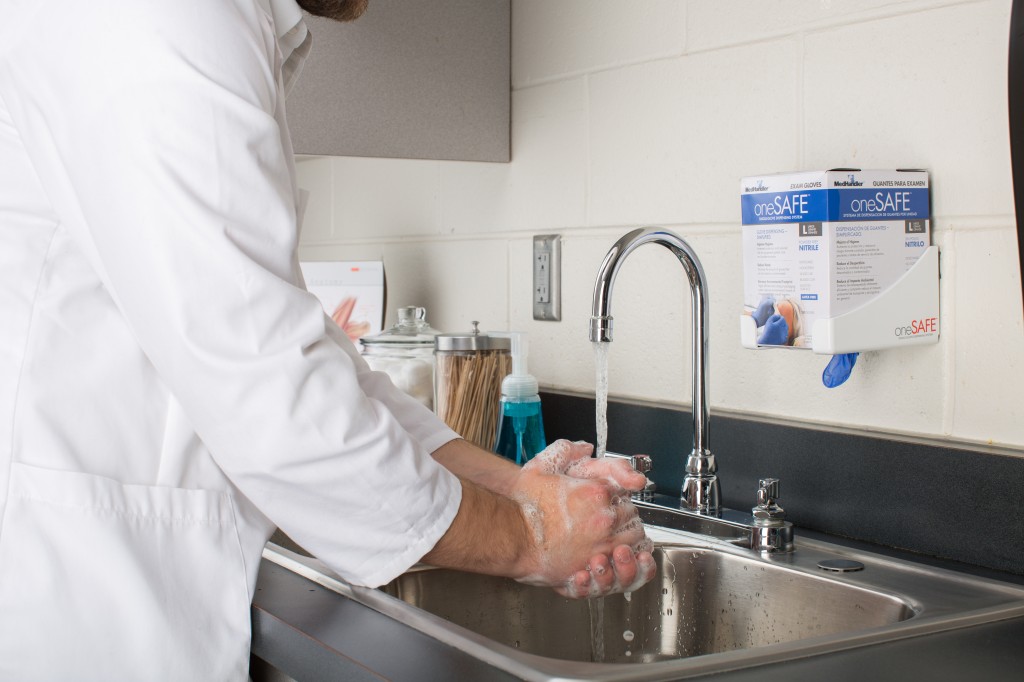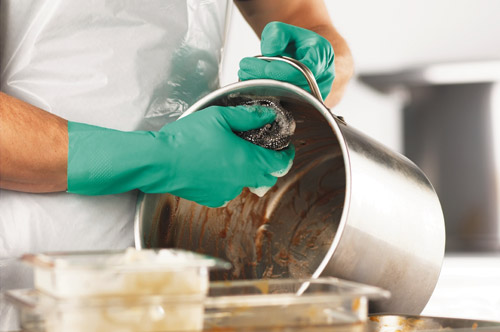The Physical Elements of Food Service Hand Hygiene – Part I
 September is National Food Safety Education Month and the theme has a rhyme to it – “Keep Hands Clean with Good Hygiene”. Hand washing is one of the public’s best defenses against the spread of both common and rare, even life-threatening, diseases including those caused by food, and against gastrointestinal infections caused by such organisms as the Norovirus, which plagues the cruise ship industry and food service in general.
September is National Food Safety Education Month and the theme has a rhyme to it – “Keep Hands Clean with Good Hygiene”. Hand washing is one of the public’s best defenses against the spread of both common and rare, even life-threatening, diseases including those caused by food, and against gastrointestinal infections caused by such organisms as the Norovirus, which plagues the cruise ship industry and food service in general.
Unfortunately, it’s not just as simple as saying I wash my hands like my mamma told me to. Every hand washing study out there shows that hand washing compliance is somewhere between 50-85% actually doing the deed—not very good news. Food service managers must consider all the hand hygiene elements and work to keep them in place to make improvements in the actual behavior of food workers associated with their hand washing practices. Hand hygiene elements are: 1) the physical equipment and tools to wash hands with; 2) the knowledge about the specific details of hand washing. Engage your employees in effective hand washing through knowledge. Educate and train them on the risks, the law, best practices and, most importantly, their personal role in serving safe food to all customers.
The Physical Hand Washing Elements– the optimum kitchen layout supports the importance of food safety in the hand hygiene process. Sometimes in older kitchens, handsinks are not strategically placed, well designed or well equipped, but work towards improvements no matter how small.
- Hand Sinks – Are the hand sinks close to each work area? Food or 3 compartment sinks cannot be used. Hand sinks should have deep wells, side splash guards if right next to food production, and preferably made of #304 stainless steel with seamless construction. If remodeling or upgrading, consider all “hands-free” — gooseneck faucets, paper towel and soap dispensers. Hand washing signs are required in the Food Code. Visit the Tools and Resources page for signage you can use!
- Soap & Hand Sanitizer—All soaps and hand sanitizers are not created equal. Talk to suppliers and try out formulations (gel, liquid or foam) to get best efficacy for removing pathogens and the kindness to the skin, rather than just buying the cheapest product. Warm water temperature can help the soap work better and encourage the frequency. Antibacterial soaps are not essential for good hand washing and do not kill viruses. A good mild soap with plenty of friction when you lather up removes the most pathogens. The best soap packaging is a bagged, airless system. A great new tool equips the soap dispensers with a digital usage counters (to monitor how many handwashes are done per day). Another good practice is having two soap dispensers at each sink to create a “never out” system. Alcohol hand sanitizers are okay if formulated correctly with skin softening emollients. They do kill bacteria fairly well, but are not effective on viruses and do dry the skin surface. Hand sanitizers never replace the hand washing practice and the Food Code requires a hand wash first before using.
- Nailbrushes or the “Claw Paw” – Fingertips, under nails, and between fingers are the source of most contamination on the hands—particularly after a restroom visit. It makes sense – almost everything we touch in kitchens is with fingertips. Studies have shown that nailbrushes create friction and dramatically enhance contaminant removal during hand washing. Controversy still exists about how to store the nailbrush in a sanitary manner. Tether it to the sink. Use a soft bristle nailbrush that has fused bristles (rather than common stapled bristles) so bacteria can’t lodge in it. If you choose not to use a nailbrush, teach food workers to use the “claw paw” by bending fingertips into the opposite palm when lathering hands.
- Paper Towels – Air dryers in kitchens are not a good option. Single-use paper towels, are the clearly the best for hand drying in the fast paced professional food handling environment. They are both effective and fast, the two critical elements of choice. Science shows us drying hands well after hand washing, removes additional levels of bacteria just from the friction.
- Gloves & Utensils – Multiple barriers to avoid touching foods with hands is a good thing. The Food Code recommends “no bare hand contact with ready-to-eat foods.” Proper use of quality, single-use, food contact gloves can significantly lower the risk of foodborne illness. Use NSF certified gloves and use the right glove for the task. Gloves and utensils deliver an added level of protection and provide a visual cue to customers that the establishment cares about their well being.
Bottom Line: Get your hand hygiene “risk control plan” started and working at your facility to improve handwashing compliance. This type of plan has been identified as an effective strategy for affecting long-term behavioral changes for food workers.
***
About the Author: Lacie Thrall

This information is provided as a general guideline and is not intended to be, nor does it, constitute legal or regulatory advice. Additional Federal regulations may apply to your particular circumstances. State, regional and local laws, ordinances and regulations may also apply.
Foodborne Illness Myths & Facts
“It must have been something I ate.” That’s the typical statement when a person develops some relatively minor symptoms from food. Maybe not severe enough to go to the doctor so you choose to tough it out without medical care. Sudden onset of flu-like symptoms such as onset of stomach cramps, diarrhea, vomiting and fever could possibly mean you are the victim of a foodborne illness. The illness is sometimes referred to as “food poisoning”, but it’s often misdiagnosed.
Don’t Compromise: Clean and Sanitize
The subject is cleaning and sanitizing. Chefs, food service directors, managers and staff try to practice safe food-handling at every turn in the kitchen. Don’t let that effort go down the drain by slacking off on the many aspects of sanitation. That includes dish and ware-washing techniques (pots, pans, equipment), and cleaning all the areas that give us that “neat as a pin” appearance in your customers eyes. Customers seldom fail to bring that soiled silverware or glass with lipstick on it to the attention of the manager or wait staff. Improperly cleaning and sanitizing of food contact equipment does allow transmission of pathogenic microorganisms to food and ultimately our customer.
The Route to Safer Fresh Fruits and Vegetables
Although fruits and vegetables are one of the healthiest foods sources in our diet, we continue to have foodborne disease outbreaks of significance from produce, sometimes affecting large groups of people in multiple states because of their wide distribution. The CDC estimates that fresh produce now causes a huge number of foodborne illness outbreaks in the United States. Produce needs our continued food safety efforts at the restaurant level as well as at the stages in agricultural production. Occasionally, fresh fruits and vegetables can become contaminated with harmful bacteria or viruses, such as Salmonella, E. coli 0157:H7, Norovirus, and Hepatitis A. This contamination can occur at any point from the field to our table. If eaten, contaminated fruits and vegetables can cause foodborne illness.
Be Cool, Chill Out, Refrigerate Promptly!
The Cold Chain -- Keeping perishable foods at proper cold holding temperatures (between 28°F and 41°F maximum or 0°F for frozen food) from your food producers / manufacturers to your customers has to be one of our strongest links to safe food and high quality. Sometimes that is referred to in the food industry as “maintaining the COLD CHAIN”. Any slip ups in the cold chain, and we have a weak link. Most all of our state food regulations require 41°F as a cold maximum, but colder is a “best practice” policy to maintain.











